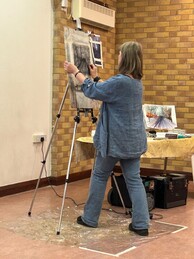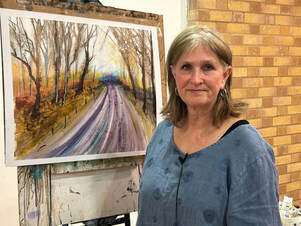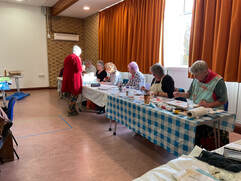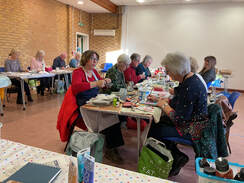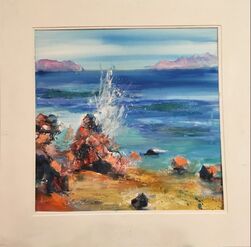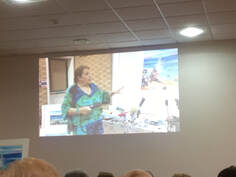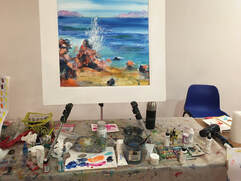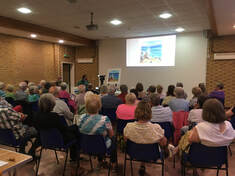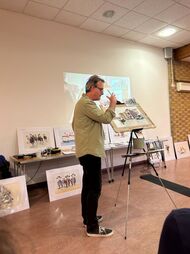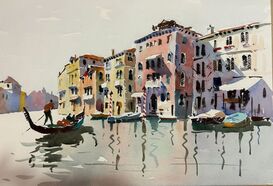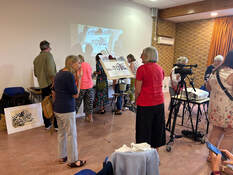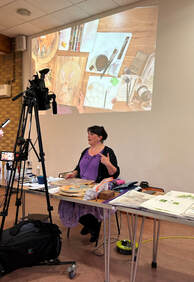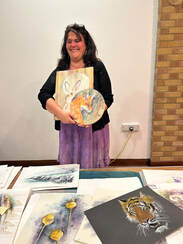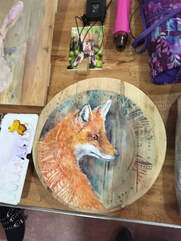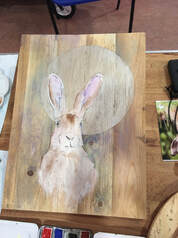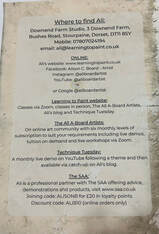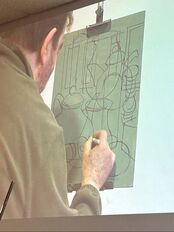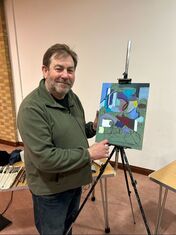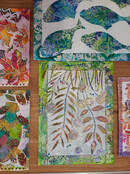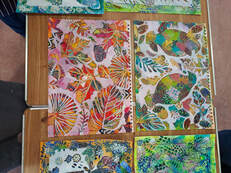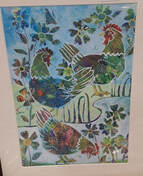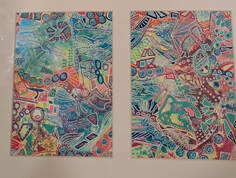Evening Meetings
|
19 June 2024 - Ronnie Ireland
In June we were entertained by Ronnie Ireland a Hampshire resident, he gave us a talk and very comprehensive slide show on the Scottish Colourists. They were John Peploe, Francis Cadell, GL Hunter and John Duncan Furgusson. All born in Scotland in the 1870s. They didn’t become known as The Scottish Colourists until the 1950.
Their style was primarily the strong confident use of paint, using liberal brush strokes showing the enjoyment of painting. They primarily painted small paintings designed to be hung in domestic settings. John Peploe moved on from impressionist style to more positive lines and shapes. He loved the arrangement of objects and would often rearrange them over several days. John Duncan Furgusson was mainly self taught, he changed his style in 1910, to strong lines and strong colours with hints of cubism. Francis Campbell Baileau painted portraits and still life, developing a pallet of blues and greys. His painting moved to a more controlled painting method. George Leslie Hunter had poor health and bad luck, he moved to California and lost all his art work in an earthquake. He painted still life in a free way ‘happy brush strokes’. |
15 May 2024 - Will Dyke
Our speaker for May was Will Dyke, he spoke about and demonstrated his love of woodcuts. Will showed us pictures of woodcuts through the ages going back as far as the medieval period, some of them incredibly intricate. He explained that when he is developing an idea he does multiple drawings, sketches and plans, he worked on Japanese ply to which he had already applied a thin coat of ink. We were shown various gouges, U gouge, V gouge and flat chisel. The woodcut is then inked and using a Barren to push the paper into the inked wood. We were all enthralled when Will went on to demonstrate how to create a repeat pattern, which first time round looked somewhat complicated.
Our speaker for May was Will Dyke, he spoke about and demonstrated his love of woodcuts. Will showed us pictures of woodcuts through the ages going back as far as the medieval period, some of them incredibly intricate. He explained that when he is developing an idea he does multiple drawings, sketches and plans, he worked on Japanese ply to which he had already applied a thin coat of ink. We were shown various gouges, U gouge, V gouge and flat chisel. The woodcut is then inked and using a Barren to push the paper into the inked wood. We were all enthralled when Will went on to demonstrate how to create a repeat pattern, which first time round looked somewhat complicated.
This month we were entertained by the very effervescent and enthusiastic Lindsey Cole giving a demonstration in acrylic on A Response to Landscape.
Lindsey explained that she creates a lot a background work before she starts a piece, she showed us a rough painting that she had created exploring the colour and tone she was looking for and she then created an impressive rough sketch in charcoal and lifting out with a rubber.
Lindsey worked on mount board that had been treated with gesso, creating a rough base to work on ( Lindsey would usually work on canvas). Using woodies (stabilo) Lindsey created an under drawing and painted in a background colour. As the work progressed Lindsey was using implements to move the paint around, turning the picture upside down and allowing ink to run through the indentations created by the gesso, she used ink on a roll to create the impression of trees and applied ‘ghosting’ a thin layer of watered down ink in several layers to create the illusion of distance. A Reservoir brush was demonstrated which looked interesting, used baby wipes to remove paint and silicone brushes for texture.
An inspiring energetic demonstration leaving some us feeling a little exhausted after watching her work.
Lindsey explained that she creates a lot a background work before she starts a piece, she showed us a rough painting that she had created exploring the colour and tone she was looking for and she then created an impressive rough sketch in charcoal and lifting out with a rubber.
Lindsey worked on mount board that had been treated with gesso, creating a rough base to work on ( Lindsey would usually work on canvas). Using woodies (stabilo) Lindsey created an under drawing and painted in a background colour. As the work progressed Lindsey was using implements to move the paint around, turning the picture upside down and allowing ink to run through the indentations created by the gesso, she used ink on a roll to create the impression of trees and applied ‘ghosting’ a thin layer of watered down ink in several layers to create the illusion of distance. A Reservoir brush was demonstrated which looked interesting, used baby wipes to remove paint and silicone brushes for texture.
An inspiring energetic demonstration leaving some us feeling a little exhausted after watching her work.
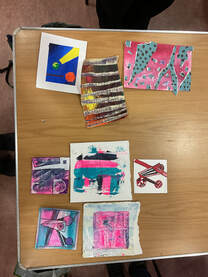
15 November 2023 - Colleen Cockroft
This afternoon was our first day time meeting and we had a fun afternoon. Colleen Cockcroft led an interactive session on ideas how to make our art more interesting. 25 of us tried painting on newspaper, treated with glue or gesso, drawing without looking, devising abstracts using coins as shapes, using rags to apply paint, and then using the rags for collage, wet wipes too, and tea bags…so many ideas to follow through. It was a really lively afternoon as you can see from some of the photos.
We’ve also added some of the handouts Colleen provided, giving some thoughtful tips on creativity.
|
19 July 2023 - Soraya French Wow ,what a brilliant evening on Wednesday . Soraya French gave a really interesting talk and demonstration to over 50 of us . She produced a seascape, but only after showing us some of the mediums and gels which she used to produced texture and depth to her work. Her practical approach to the use of Golden paints and products , as well as her brief history of the development of Golden acrylics was refreshing and informative. She has offered to provide a workshop for us, and as she is an ambassador for Golden products it should be good value. We look forward to seeing you all during the course of our summer exhibition, particularly if you are unable to come to the reception on the first Saturday of the exhibition, 5th August. |
21 June 2023 - Jake Winkle
Our June demonstration was by Jake Winkle, who has demonstrated to us before, this time to painted a Venetian scene in watercolour. It was fascinating to learn how he built up the picture, starting with darker colours , which enabled him to decide which spaces to leave unpainted and where to apply light washes, thus producing a light and airy picture.
Jake is a well known demonstrator and contributor to art magazines and he was an absorbing speaker. Our meeting was well attended and enjoyed by all.
Jake is a well known demonstrator and contributor to art magazines and he was an absorbing speaker. Our meeting was well attended and enjoyed by all.
|
17 May 2023 - Alison Board
|
Wow what an interesting, exuberant speaker we had this June. Alison Board was so enthusiastic and knowledgeable about her subject that listening to and watching her was infectious. Alison told us that she started out learning to understand art materials and sold art materials, which gave her access to all sorts of artists and inspiration. Alison said that she likes to work intuitively. She is also very particular about her paints, including environmentally and has developed her own range of paints. Alison explained that she considers her work to be a cross over between art and craft and she is always looking for different ways to use paint and materials i.e., re appropriating materials. For our demonstration she was working on palette wood, kindly prepared and sanded by her husband. We were told that when working on wood the surface must be prepared using several coats of transparent water colour ground because the surface of the wood is porous, and the water colour paint will be soaked up, using this method does mean that the water colour paint remains wet for a long time. Other materials demonstrated were powdered water colour paints including luminescent paints, lettering stamps, stencils (which interestingly can be used to put paint on or take it off), Uni pin and Poska acrylic pen marker. Once finished the work can be protected by a gentle coat of wax. As a member of the SAA she offered us a discount code to use when purchasing products on line, ALIB10. You should be able to learn more about Alison from her information sheet below. |
9 April 2023
This month’s demonstrator was Max Hale who spoke and demonstrated ‘Into Abstraction’. Max was a fascinating and knowledgeable speaker, particularly enjoyed by the abstract artists in the audience. Max told us that ‘abstraction is personal and not easy’, he said ‘abstraction is about your emotions and feeling’. He explained that with abstraction it can’t be wrong because its about what you want to portray, you don’t produce something by accident you have to intend to create. If you don’t intend it’s not art! When you paint in abstract, your whole personality is absorbed in the painting..
This month’s demonstrator was Max Hale who spoke and demonstrated ‘Into Abstraction’. Max was a fascinating and knowledgeable speaker, particularly enjoyed by the abstract artists in the audience. Max told us that ‘abstraction is personal and not easy’, he said ‘abstraction is about your emotions and feeling’. He explained that with abstraction it can’t be wrong because its about what you want to portray, you don’t produce something by accident you have to intend to create. If you don’t intend it’s not art! When you paint in abstract, your whole personality is absorbed in the painting..
|
19 October 2022 - Teresa Rogers
|






